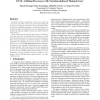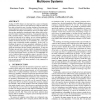SASP
2008
IEEE
14 years 3 months ago
2008
IEEE
—Accelerators are special purpose processors designed to speed up compute-intensive sections of applications. Two extreme endpoints in the spectrum of possible accelerators are F...
SASP
2008
IEEE
14 years 3 months ago
2008
IEEE
Different approaches have been proposed over the years for automatically transforming High-Level-Languages (HLL) descriptions of applications into custom hardware implementations. ...
SASP
2008
IEEE
14 years 3 months ago
2008
IEEE
— Matrix inversion is a common function found in many algorithms used in wireless communication systems. As FPGAs become an increasingly attractive platform for wireless communic...
MICRO
2008
IEEE
14 years 3 months ago
2008
IEEE
— Processor architectures with large instruction windows have been proposed to expose more instruction-level parallelism (ILP) and increase performance. Some of the proposed arch...
MICRO
2008
IEEE
14 years 3 months ago
2008
IEEE
Traditional coherence protocols present a set of difficult tradeoffs: the reliance of snoopy protocols on broadcast and ordered interconnects limits their scalability, while dire...
MICRO
2008
IEEE
14 years 3 months ago
2008
IEEE
Parameter variation in integrated circuits causes sections of a chip to be slower than others. If, to prevent any resulting timing errors, we design processors for worst-case para...
MICRO
2008
IEEE
14 years 3 months ago
2008
IEEE
—Negative bias temperature instability (NBTI), which reduces the lifetime of PMOS transistors, is becoming a growing reliability concern for sub-micrometer CMOS technologies. Par...
MICRO
2008
IEEE
14 years 3 months ago
2008
IEEE
Shrinking transistor sizes and a trend toward low-power processors have caused increased leakage, high per-device variation and a larger number of hard and soft errors. Maintainin...
MICRO
2008
IEEE
14 years 3 months ago
2008
IEEE
Existing DRAM controllers employ rigid, non-adaptive scheduling and buffer management policies when servicing prefetch requests. Some controllers treat prefetch requests the same ...
MICRO
2008
IEEE
14 years 3 months ago
2008
IEEE
Scaling of CMOS feature size has long been a source of dramatic performance gains. However, the reduction in voltage levels has not been able to match this rate of scaling, leadin...


